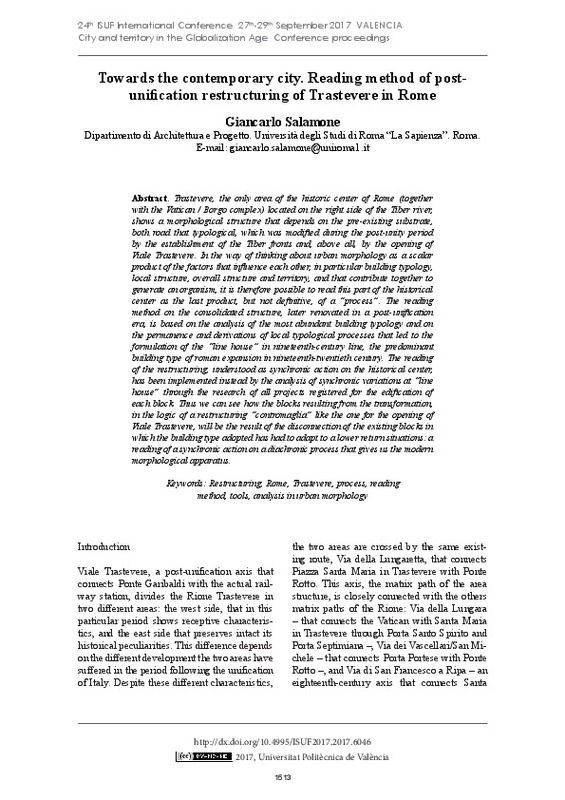JavaScript is disabled for your browser. Some features of this site may not work without it.
Buscar en RiuNet
Listar
Mi cuenta
Estadísticas
Ayuda RiuNet
Admin. UPV
Towards the contemporary city. Reading method of post-unification restructuring of Trastevere in Rome
Mostrar el registro sencillo del ítem
Ficheros en el ítem
| dc.contributor.author | Salamone, Giancarlo
|
es_ES |
| dc.coverage.spatial | east=12.470401700000025; north=41.8848294; name=Viale di Trastevere, 76A, 00153 Roma RM, Itàlia | es_ES |
| dc.date.accessioned | 2018-12-19T07:59:39Z | |
| dc.date.available | 2018-12-19T07:59:39Z | |
| dc.date.issued | 2018-04-20 | |
| dc.identifier.isbn | 9788490485743 | |
| dc.identifier.uri | http://hdl.handle.net/10251/114151 | |
| dc.description.abstract | [EN] Trastevere, the only area of the historic center of Rome (together with the Vatican / Borgo complex) located on the right side of the Tiber river, shows a morphological structure that depends on the pre-existing substrate, both road that typological, which was modified during the post-unity period by the establishment of the Tiber fronts and, above all, by the opening of Viale Trastevere. In the way of thinking about urban morphology as a scalar product of the factors that influence each other, in particular building typology, local structure, overall structure and territory, and that contribute together to generate an organism, it is therefore possible to read this part of the historical center as the last product, but not definitive, of a "process". The reading method on the consolidated structure, later renovated in a post-unification era, is based on the analysis of the most abundant building typology and on the permanence and derivations of local typological processes that led to the formulation of the “line house” in nineteenth-century line, the predominant building type of roman expansion in nineteenth-twentieth century. The reading of the restructuring, understood as synchronic action on the historical center, has been implemented instead by the analysis of synchronic variations at “line house” through the research of all projects registered for the edification of each block. Thus we can see how the blocks resulting from the transformation, in the logic of a restructuring "contromaglia" like the one for the opening of Viale Trastevere, will be the result of the disconnection of the existing blocks in which the building type adopted has had to adapt to a lower return situations: a reading of a synchronic action on a diachronic process that gives us the modern morphological apparatus. | es_ES |
| dc.format.extent | 9 | es_ES |
| dc.language | Inglés | es_ES |
| dc.publisher | Editorial Universitat Politècnica de València | es_ES |
| dc.relation.ispartof | 24th ISUF International Conference. Book of Papers | es_ES |
| dc.rights | Reconocimiento - No comercial - Sin obra derivada (by-nc-nd) | es_ES |
| dc.subject | Restructuring | es_ES |
| dc.subject | Rome | es_ES |
| dc.subject | Trastevere | es_ES |
| dc.subject | Process | es_ES |
| dc.subject | Reading method | es_ES |
| dc.subject | Tools | es_ES |
| dc.subject | Analysis in urban morphology | es_ES |
| dc.title | Towards the contemporary city. Reading method of post-unification restructuring of Trastevere in Rome | es_ES |
| dc.type | Capítulo de libro | es_ES |
| dc.type | Comunicación en congreso | es_ES |
| dc.identifier.doi | 10.4995/ISUF2017.2017.6046 | |
| dc.rights.accessRights | Abierto | es_ES |
| dc.description.bibliographicCitation | Salamone, G. (2018). Towards the contemporary city. Reading method of post-unification restructuring of Trastevere in Rome. En 24th ISUF International Conference. Book of Papers. Editorial Universitat Politècnica de València. 1513-1521. https://doi.org/10.4995/ISUF2017.2017.6046 | es_ES |
| dc.description.accrualMethod | OCS | es_ES |
| dc.relation.conferencename | 24th ISUF 2017 - City and Territory in the Globalization Age | es_ES |
| dc.relation.conferencedate | Septiembre 27-29,2017 | es_ES |
| dc.relation.conferenceplace | Valencia, Spain | es_ES |
| dc.relation.publisherversion | http://ocs.editorial.upv.es/index.php/ISUF/ISUF2017/paper/view/6046 | es_ES |
| dc.description.upvformatpinicio | 1513 | es_ES |
| dc.description.upvformatpfin | 1521 | es_ES |
| dc.type.version | info:eu-repo/semantics/publishedVersion | es_ES |
| dc.relation.pasarela | OCS\6046 | es_ES |








